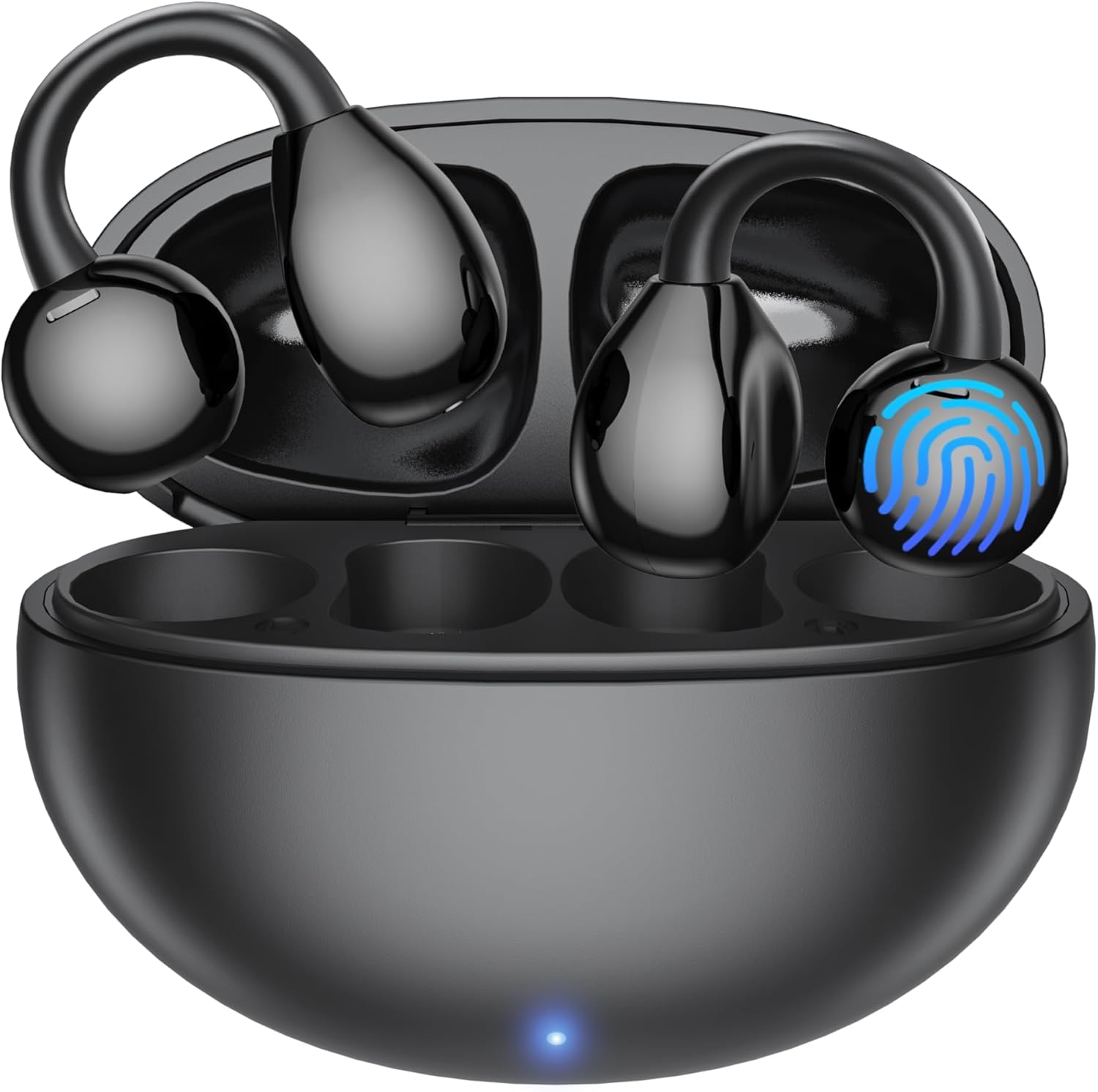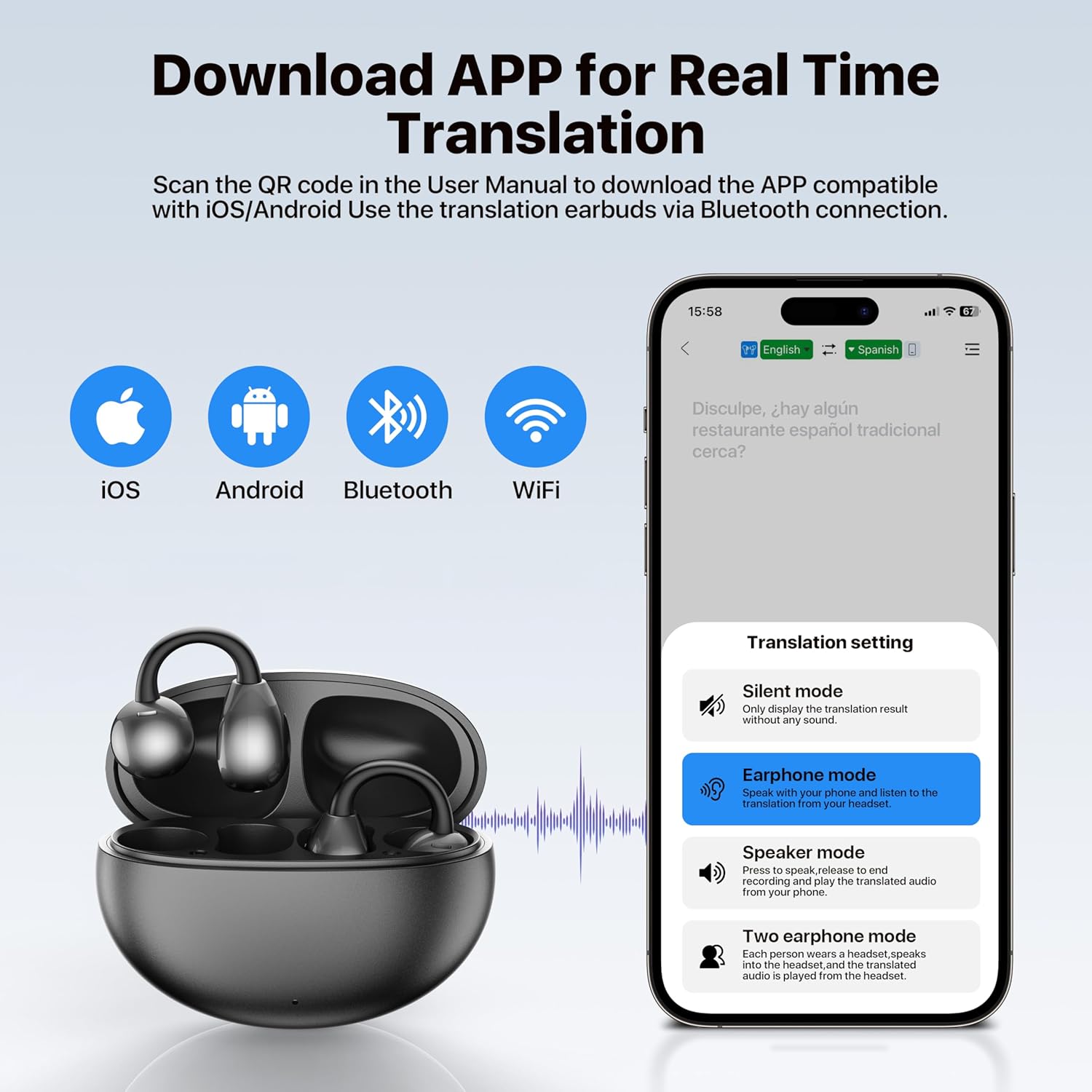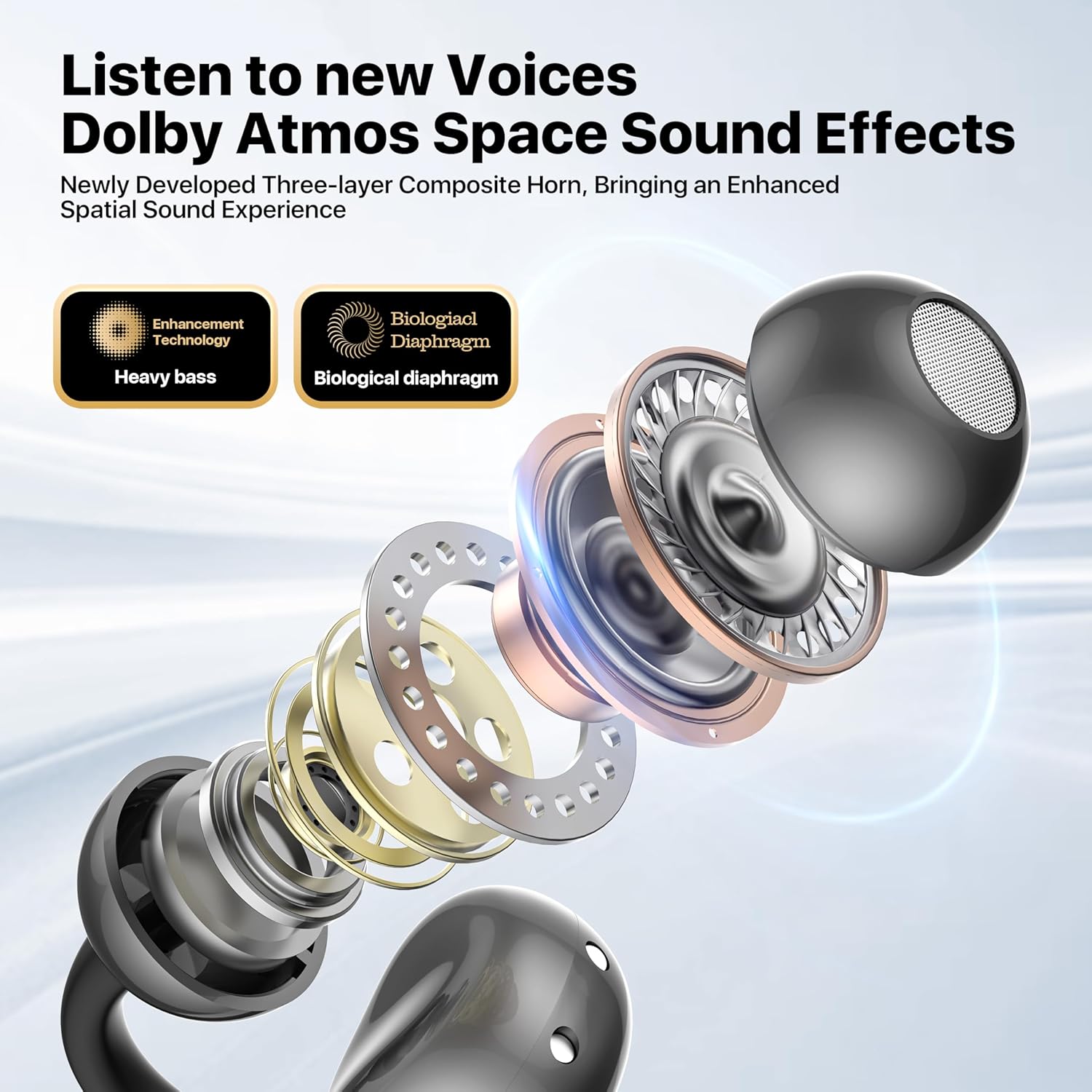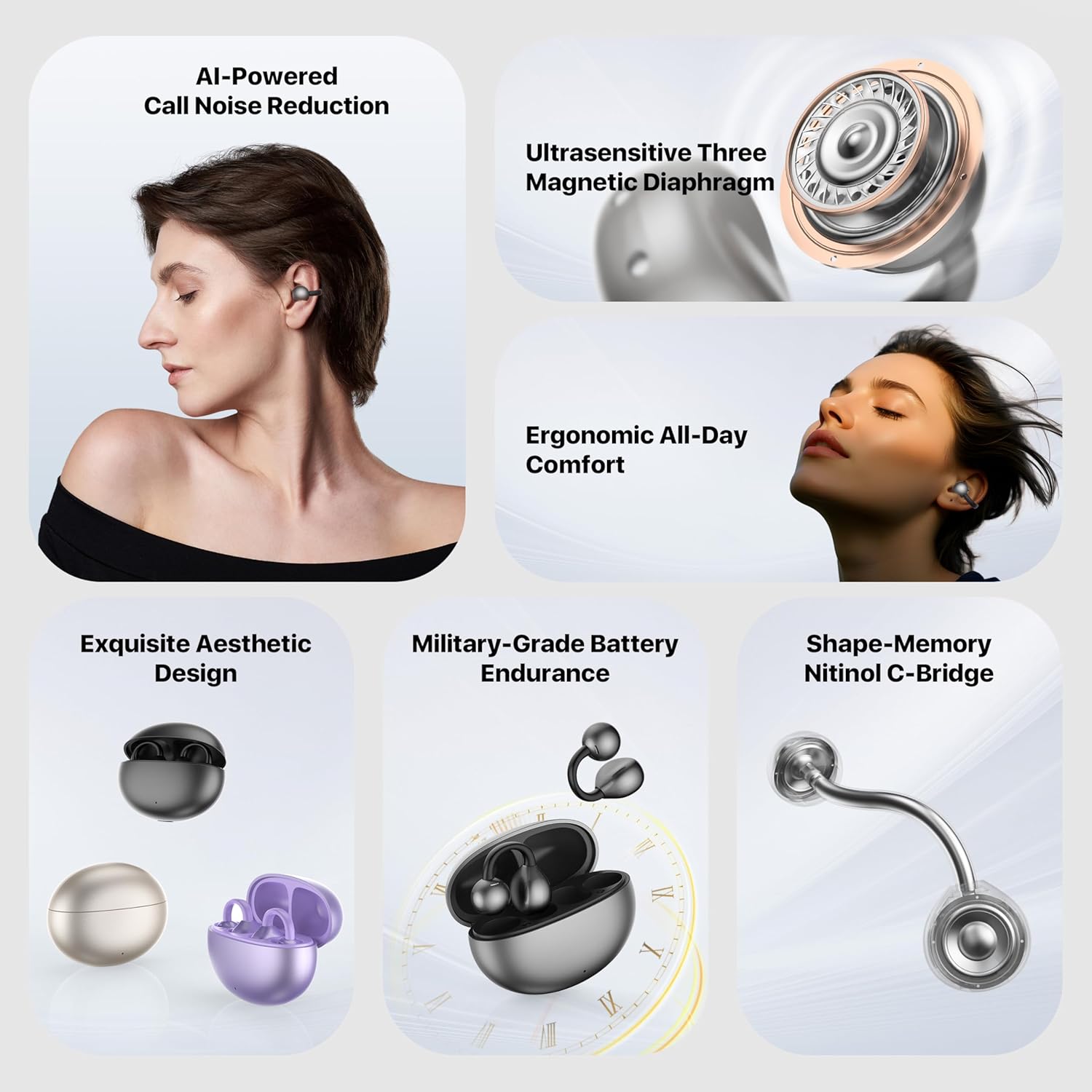
AI Translator Earbuds, Real Time 3-in-1 Review translate – Oemiu
AI Translator Earbuds: A Deep Dive into Real-Time Translation Technology
Imagine a world without language barriers. A world where you could converse freely with anyone, anywhere, regardless of their native tongue. This vision, once relegated to science fiction, is rapidly becoming a reality thanks to advancements in artificial intelligence and miniaturized technology. At the forefront of this revolution are AI translator earbuds – compact, wearable devices that promise to translate speech in real time, breaking down communication barriers and fostering global understanding. But do these devices live up to the hype? This article provides a comprehensive, in-depth review, exploring the technology behind them, their practical applications, and the challenges they still face.
The Promise of Seamless Communication: Unpacking the Technology
The core concept behind AI translator earbuds is deceptively simple: capture audio, process it through an AI-powered translation engine, and deliver the translated audio directly to the user’s ear. The execution, however, is a complex feat of engineering and software development. These earbuds rely on a combination of several key technologies working in concert. First, highly sensitive microphones are crucial for accurately capturing speech in noisy environments. Noise cancellation algorithms play a vital role in filtering out background distractions, ensuring that the AI engine receives a clean audio signal. This is particularly important in crowded cafes, busy streets, or conference halls, where ambient noise can easily overwhelm the intended speech. The processing power, despite the tiny size of the earbud, needs to be sufficient to handle real-time audio analysis and translation. These processors are typically custom-designed systems-on-a-chip (SoCs) optimized for low power consumption and high performance. The AI translation engine itself is the heart of the system. These engines are trained on massive datasets of multilingual text and speech, utilizing sophisticated deep learning models to accurately translate between languages. The accuracy and speed of the translation depend heavily on the quality and size of the training data, as well as the complexity of the AI algorithms. Finally, the translated audio must be delivered to the user in a clear and natural-sounding voice. Text-to-speech (TTS) technology is used to synthesize the translated speech, and advancements in TTS have made significant strides in recent years, resulting in more human-like and less robotic-sounding voices.
The entire process, from capturing the initial sound wave to delivering the translated audio, must happen in near real-time to maintain a natural conversational flow. This requires minimizing latency – the delay between speaking and hearing the translation. Even a slight delay can disrupt the conversation and make it difficult to understand and respond effectively. Manufacturers are constantly working to optimize their algorithms and hardware to reduce latency to imperceptible levels. Cloud connectivity is another crucial aspect of many AI translator earbuds. While some devices can perform basic translation offline using pre-loaded language packs, the most accurate and comprehensive translation often requires access to cloud-based AI engines. This allows the earbuds to leverage the vast processing power and constantly evolving datasets of cloud servers, ensuring that the translations are as accurate and up-to-date as possible. This reliance on the cloud, however, raises concerns about data privacy and security, as the audio data must be transmitted to and processed by remote servers. The best AI translator earbuds offer robust encryption and data protection measures to safeguard user privacy.
Consider the scenario of a business professional traveling to Japan for a crucial negotiation. Without language skills, the meeting could be a daunting prospect. But equipped with AI translator earbuds, they can confidently engage in conversations with their Japanese counterparts, understanding their nuances and responding appropriately. Or imagine a tourist exploring a bustling market in Morocco. Unable to speak Arabic, they might feel hesitant to interact with local vendors. But with these earbuds, they can easily bargain for souvenirs, ask for directions, and immerse themselves in the local culture. These are just a few examples of how AI translator earbuds can empower individuals to connect with others and experience the world in new ways. However, the reality isn’t always perfect.
Real-World Applications and Use Cases: Beyond the Hype
AI translator earbuds have the potential to revolutionize various aspects of our lives, far beyond simple travel and tourism. In the business world, they can facilitate international collaborations, streamline negotiations, and expand global reach. Imagine teams from different countries working seamlessly together on projects, communicating effortlessly regardless of their native languages. Sales representatives can confidently engage with clients from around the world, building rapport and closing deals without the need for human interpreters. In the medical field, these earbuds can bridge the communication gap between doctors and patients who speak different languages, ensuring that patients receive the best possible care. This is particularly crucial in emergency situations where clear and accurate communication is paramount. Consider a scenario where a non-English speaking tourist is involved in an accident in an English-speaking country. AI translator earbuds can enable paramedics and doctors to quickly assess the patient’s condition, understand their medical history, and provide appropriate treatment. The translation process itself can also help the patient feel more comfortable and less anxious during a stressful situation.
Education is another area where AI translator earbuds can have a significant impact. Language learners can use them to immerse themselves in new languages, practicing their speaking and listening skills with native speakers. The earbuds can provide instant feedback on pronunciation and grammar, helping learners to improve their fluency. Furthermore, they can facilitate cross-cultural exchange programs, allowing students from different countries to collaborate on projects and learn from each other’s perspectives. They could be used to translate lectures or online courses in real-time, making educational resources more accessible to a wider audience. Think of a student from Spain attending an online lecture in English. With AI translator earbuds, they can follow the lecture seamlessly, understanding every concept and nuance without struggling with the language barrier. The technology also holds promise for assisting refugees and immigrants who are trying to integrate into new communities. These earbuds can help them to communicate with social workers, access essential services, and find employment. The ability to communicate effectively is crucial for successful integration, and AI translator earbuds can provide a valuable tool for overcoming language barriers. Imagine a refugee arriving in a new country, struggling to navigate the healthcare system or find suitable housing. With these earbuds, they can communicate their needs and concerns to service providers, ensuring that they receive the support they need.
However, it’s important to acknowledge the current limitations. Translation accuracy can vary depending on the language pair, the complexity of the sentence structure, and the presence of accents or dialects. While AI translation technology has made significant progress, it is not yet perfect. There are still instances where the translation may be inaccurate or nonsensical, particularly when dealing with idioms, slang, or cultural references. Furthermore, the performance of the earbuds can be affected by noisy environments or poor internet connectivity. In situations where a high degree of accuracy is required, such as legal or financial transactions, it may still be necessary to rely on human interpreters. The effectiveness of these earbuds is undeniably dependent on numerous factors, including strong signal, regular updates, and, sometimes, the quality of the user’s pronunciation itself when the device is trying to translate what they say.
The 3-in-1 Advantage: Beyond Simple Translation
Many modern AI translator earbuds offer functionalities beyond just real-time translation, positioning themselves as comprehensive audio companions. This “3-in-1” approach typically encompasses translation, music playback, and hands-free calling capabilities. Integrating these features into a single device streamlines the user experience and enhances the overall value proposition. The ability to listen to music while traveling or commuting is a standard expectation for earbuds, and AI translator earbuds seamlessly integrate this functionality. They can connect to smartphones or other devices via Bluetooth, allowing users to stream their favorite music, podcasts, or audiobooks. Furthermore, they often include features like active noise cancellation (ANC) to enhance the listening experience by blocking out ambient noise. This is particularly useful in noisy environments such as airplanes or trains. High-quality audio codecs and well-tuned drivers ensure that the music sounds clear and crisp, providing an immersive listening experience.
Hands-free calling is another essential feature for modern earbuds, and AI translator earbuds are no exception. They typically include built-in microphones and voice recognition technology, allowing users to make and receive calls without having to take their phone out of their pocket. The microphones are designed to capture the user’s voice clearly, even in noisy environments, and noise cancellation algorithms help to reduce background distractions. This allows for clear and natural conversations, whether the user is walking down the street or sitting in a coffee shop. Some AI translator earbuds also support voice assistants like Siri or Google Assistant, allowing users to control their music, make calls, or access information hands-free. This adds another layer of convenience and functionality to the device. The combination of translation, music playback, and hands-free calling capabilities makes AI translator earbuds a versatile and valuable tool for both personal and professional use. They offer a convenient and seamless way to stay connected, entertained, and informed, regardless of language barriers.
Consider the busy professional who needs to attend a virtual meeting with colleagues from different countries. With AI translator earbuds, they can participate actively in the conversation, understanding and responding to their colleagues in real-time. During breaks, they can listen to their favorite music to relax and recharge. And when they need to make a call, they can do so hands-free, without having to fumble with their phone. The “3-in-1” functionality streamlines their workflow and allows them to stay productive and connected throughout the day. Or imagine a student who is learning a new language. They can use the AI translator earbuds to practice their speaking skills with native speakers, listen to foreign language music to improve their listening comprehension, and make hands-free calls to their language partners. The integrated functionality makes learning a language more engaging and convenient. The device enables translating content in a seamless and practical way.
Comparing the Options: Features, Specifications, and Price
The market for AI translator earbuds is rapidly evolving, with numerous manufacturers offering a variety of models with different features, specifications, and price points. Choosing the right pair of earbuds can be a daunting task, so it’s important to carefully consider your needs and priorities. Some of the key features to consider include translation accuracy, language support, battery life, comfort, noise cancellation, and connectivity. Translation accuracy is arguably the most important factor, as it directly affects the effectiveness of the earbuds. Look for models that have been tested and reviewed by independent sources, and pay attention to the language pairs that are supported. The more languages supported, the more versatile the earbuds will be. Battery life is another crucial consideration, especially if you plan to use the earbuds for extended periods of time. Look for models that offer at least 5-6 hours of continuous translation on a single charge, and consider whether the charging case provides additional battery life. Comfort is also important, as you’ll be wearing the earbuds for extended periods of time. Look for models that come with multiple ear tip sizes to ensure a comfortable and secure fit. Active noise cancellation (ANC) can significantly improve the listening experience, especially in noisy environments. Look for models that offer adjustable ANC levels, allowing you to customize the level of noise cancellation to your preferences. Finally, consider the connectivity options. Most AI translator earbuds connect to smartphones and other devices via Bluetooth, but some models also support Wi-Fi connectivity for accessing cloud-based translation services.
Here’s a comparison table of several theoretical brands:
| Brand & Model | Translation Accuracy | Language Support | Battery Life | Noise Cancellation | Price |
|---|---|---|---|---|---|
| LinguaTech Pro | High | 40+ Languages | 6 hours (24 hours with case) | Excellent | $299 |
| GlobalEar Standard | Medium | 20+ Languages | 4 hours (16 hours with case) | Good | $199 |
| Polyglot Buds Lite | Low | 10+ Languages | 3 hours (12 hours with case) | Basic | $99 |
| WorldSpeak Elite | Very High | 50+ Languages | 7 hours (28 hours with case) | Advanced | $399 |
Price is, of course, a major consideration. AI translator earbuds range in price from around $100 to $400 or more, depending on the features and specifications. It’s important to set a budget and stick to it, but don’t sacrifice quality for price. Reading reviews from independent sources is a good way to get a sense of the real-world performance of different models. Remember that the best AI translator earbuds for you will depend on your individual needs and priorities. Consider how you plan to use the earbuds and choose a model that meets those needs. Are you primarily concerned with translation accuracy, or are you more interested in features like music playback and noise cancellation? Do you need support for a wide range of languages, or are you only interested in a few specific languages? Answering these questions will help you narrow down your options and choose the right pair of AI translator earbuds. The ability to accurately translate speech is getting more important in the modern world.
Addressing the Challenges and Future Outlook
Despite the significant progress made in AI translation technology, several challenges remain. One of the biggest challenges is improving translation accuracy, particularly for less common language pairs and in noisy environments. While AI translation engines have become incredibly sophisticated, they are still not perfect. They can struggle with idioms, slang, cultural references, and complex sentence structures. Furthermore, the accuracy of the translation can be affected by accents, dialects, and the quality of the audio input. Another challenge is reducing latency, the delay between speaking and hearing the translation. Even a slight delay can disrupt the conversational flow and make it difficult to understand and respond effectively. Manufacturers are constantly working to optimize their algorithms and hardware to reduce latency to imperceptible levels. Data privacy and security are also major concerns. AI translator earbuds typically require access to cloud-based translation services, which means that the audio data must be transmitted to and processed by remote servers. This raises concerns about who has access to the data and how it is being used. Manufacturers need to implement robust encryption and data protection measures to safeguard user privacy.
The future of AI translator earbuds is bright. As AI technology continues to advance, we can expect to see even more accurate and reliable translation, support for a wider range of languages, and improved latency. We can also expect to see new features and functionalities, such as offline translation, personalized translation profiles, and integration with other devices and platforms. Imagine a future where AI translator earbuds can automatically detect the language being spoken and translate it in real-time, without the need for manual selection. Or imagine a future where the earbuds can learn your personal preferences and adapt the translation to your individual style and vocabulary. The potential applications of AI translator earbuds are vast and far-reaching. They can empower individuals to connect with others, bridge cultural divides, and create a more inclusive and interconnected world. As the technology matures and becomes more affordable, we can expect to see AI translator earbuds become an indispensable tool for travelers, business professionals, students, and anyone who wants to communicate with people from different cultures.
FAQ: Frequently Asked Questions About AI Translator Earbuds
How accurate are AI translator earbuds?
The accuracy of AI translator earbuds varies depending on several factors, including the language pair, the complexity of the sentence structure, and the quality of the audio input. While AI translation technology has made significant progress in recent years, it is not yet perfect. In general, the accuracy is higher for common language pairs like English and Spanish than for less common pairs. The accuracy also tends to be higher for simple sentences than for complex sentences. In noisy environments, the accuracy can be reduced due to background distractions. It’s important to manage expectations and understand that AI translator earbuds are not a substitute for human interpreters, particularly in situations where a high degree of accuracy is required. Many users have reported accuracies ranging from 80-95% in ideal conditions. However, this can drop significantly in real-world scenarios. Before purchasing, checking independent reviews and understanding the limitations is always recommended.
What languages do AI translator earbuds support?
The number of languages supported by AI translator earbuds varies depending on the manufacturer and the model. Some models support only a handful of languages, while others support dozens or even hundreds. The most commonly supported languages include English, Spanish, French, German, Chinese, Japanese, and Korean. However, many models also support a wide range of other languages, including less common ones. Before purchasing AI translator earbuds, it’s important to check the list of supported languages to ensure that they include the languages you need. Some manufacturers also offer downloadable language packs, which allow you to add support for additional languages. Keep in mind that the accuracy of the translation may vary depending on the language. The best AI translator earbuds will typically support a wide range of languages and offer accurate translation for most of them. Most manufacturers provide a list of supported languages on their website or in the product documentation.
How long does the battery last on AI translator earbuds?
The battery life of AI translator earbuds varies depending on the model and the usage. In general, you can expect to get around 4-8 hours of continuous translation on a single charge. Some models offer longer battery life, while others offer shorter. The battery life can also be affected by factors such as the volume level, the noise cancellation setting, and the ambient temperature. Most AI translator earbuds come with a charging case, which can provide additional battery life. The charging case typically holds several full charges, allowing you to use the earbuds for extended periods of time without having to plug them in. When choosing AI translator earbuds, it’s important to consider the battery life and the charging case to ensure that they meet your needs. If you plan to use the earbuds for extended periods of time, look for a model that offers long battery life and a charging case with multiple charges. The standby time, which is how long the earbuds can last without being used, is also an important consideration.
Are AI translator earbuds comfortable to wear?
The comfort of AI translator earbuds depends on the design, the materials used, and the fit. Most models come with multiple ear tip sizes, allowing you to customize the fit to your ears. It’s important to choose ear tips that are comfortable and secure, as this will prevent the earbuds from falling out and ensure that the audio quality is optimal. Some models also feature ergonomic designs that conform to the shape of the ear, providing a more comfortable and secure fit. The weight of the earbuds can also affect the comfort. Lighter earbuds are generally more comfortable to wear for extended periods of time. If you have sensitive ears, look for models that are made from hypoallergenic materials. It’s also a good idea to read reviews from other users to get a sense of the real-world comfort of different models. Trying the earbuds on before you buy them is the best way to ensure that they are comfortable for you. Some retailers offer demo units that you can try on in the store. Many premium brands focus on ensuring the comfort is one of the primary concerns while building the translation earbuds.
Do AI translator earbuds require an internet connection?
Most AI translator earbuds require an internet connection to access cloud-based translation services. These services provide the most accurate and up-to-date translations. However, some models also offer offline translation, which allows you to translate between a limited number of languages without an internet connection. Offline translation is useful for situations where you don’t have access to Wi-Fi or cellular data. The accuracy of offline translation is typically lower than online translation, but it can still be helpful in a pinch. If you plan to use AI translator earbuds in areas where you don’t have access to the internet, look for a model that offers offline translation. Keep in mind that the number of languages supported for offline translation may be limited. Even with offline translation capabilities, regularly updating the firmware and language packs requires an internet connection.
Are AI translator earbuds secure and private?
Data privacy and security are important considerations when using AI translator earbuds, as the audio data is often transmitted to and processed by remote servers. Most manufacturers implement encryption and data protection measures to safeguard user privacy. However, it’s important to read the privacy policy carefully to understand how your data is being used. Some manufacturers may collect and store your audio data for research and development purposes. If you are concerned about privacy, look for models that offer end-to-end encryption, which ensures that your data is protected from eavesdropping. It’s also a good idea to disable any features that you don’t need, such as voice recording or location tracking. Choosing reputable brands with a strong track record of protecting user privacy is also important. Being mindful of where and how you use your AI translator earbuds can also help to protect your privacy.
How much do AI translator earbuds cost?
The cost of AI translator earbuds varies depending on the features, specifications, and brand. Basic models can cost as little as $100, while premium models can cost $400 or more. The price typically reflects the accuracy of the translation, the number of languages supported, the battery life, the comfort, and the features. It’s important to set a budget and stick to it, but don’t sacrifice quality for price. Reading reviews from independent sources is a good way to get a sense of the value of different models. Consider how you plan to use the earbuds and choose a model that meets those needs. If you only need basic translation for a few languages, a cheaper model may be sufficient. However, if you need accurate translation for a wide range of languages, you may need to invest in a more expensive model. Also, be sure to factor in the cost of accessories, such as extra ear tips or a protective case. Many retailers offer discounts and promotions, so it’s worth shopping around to find the best deal.











